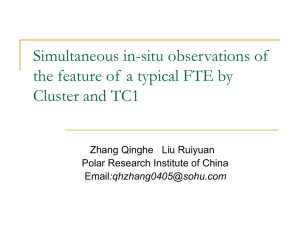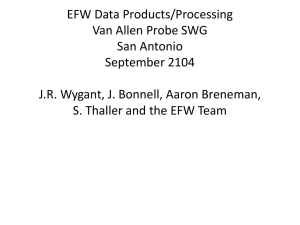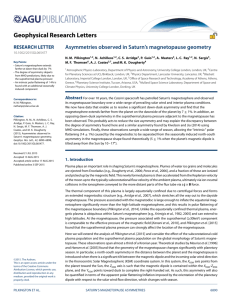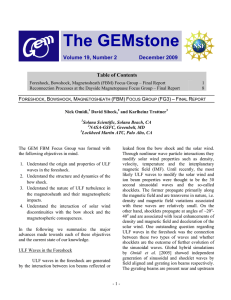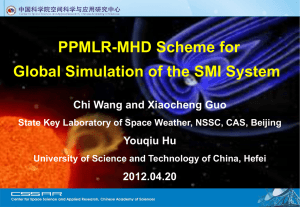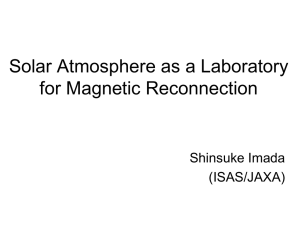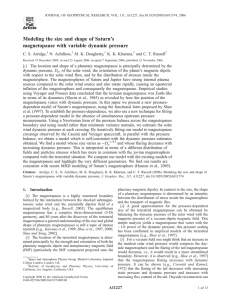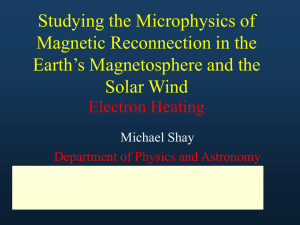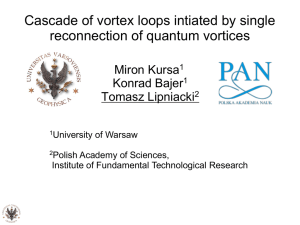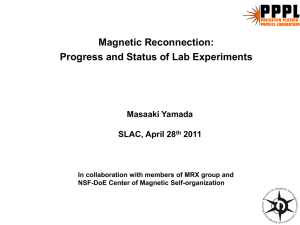phan_dayside
advertisement
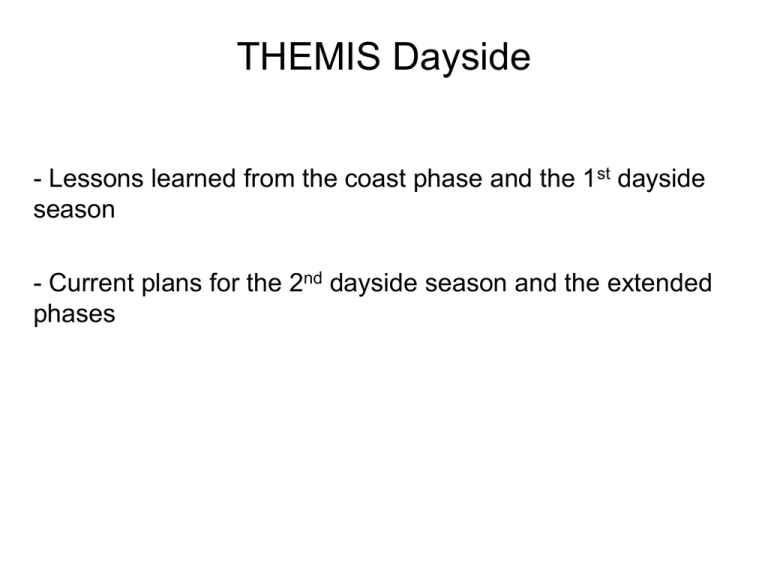
THEMIS Dayside
- Lessons learned from the coast phase and the 1st dayside
season
- Current plans for the 2nd dayside season and the extended
phases
Orbit for Coast Phase
Coast Phase: May-September 2007
Apogee: ~15 RE
Spacecraft Separation:
1-3 RE between leading and trailing S/C
100’s km between inner three S/C
Ideal for studying the structure and dynamics of the
magnetopause and boundary layer:
Unique THEMIS contributions:
- Transmission of Hot Flow Anomalies through the bow shock [Eastwood et al.,
2008]
- FTE structure and remote sensing {Sibeck et al.; Lui et al.; Liu et al., 2008]
- Thick subsolar LLBL during northward IMF and implications for dual-lobe
reconnection [McFadden et al., 2008; Oieroset et al., 2008; Li et al., 2008]
Structures of Flux Transfer Events
C
A
E
B
D
Sibeck et al. [GRL, 2008]
Lui et al. [2008; JGR}
Orbit for Coast Phase
Coast Phase: May-September 2007
Apogee: ~15 RE
Spacecraft Separation:
1-3 RE between leading and trailing S/C
100’s km between inner three S/C
Ideal for studying the structure and dynamics of the
magnetopause and boundary layer:
Unique THEMIS contributions:
- Transmission of Hot Flow Anomalies through the bow shock [Eastwood et al.,
2008]
- FTE structure and remote sensing {Sibeck et al.; Lui et al.; Liu et al., 2008]
- Thick subsolar LLBL during northward IMF and implications for dual-lobe
reconnection [McFadden et al., 2008; Oieroset et al., 2008; Li et al., 2008]
what we wished we had during the coast phase
• Burst data at the magnetopause and bow shock
– 3s full 3-D electron distributions for the determination of field line
topology at the magnetopause and in FTE
• 24/7 onboard plasma moments
• EFI on all spacecraft
1st Dayside Season
Dayside Science Phase: May-September 2008
2008-08-08
1 S/C at 30 RE: pristine solar wind
1 S/C at 18 RE: solar wind/foreshock
3 S/C at 11-12 RE: magnetopause/magnetosheath
ideal for studying the response of magnetopause
processes to various solar wind conditions
Unique THEMIS contributions:
- MP-Bow Shock crossings 5-min apart due to arrival of solar wind
discontinuities
[Hui Zhang, GSFC].
- Extreme MP motion (800 km/s) due to a Hot Flow Anomaly [Jacobsen, Oslo].
The deformation and expansion of the MP
from 4-spacecraft measurements
MP moved outward by 4.8 RE in 71s
Bulge moved tailward along the MP at 350 km/s
what we wished we had during the dayside phase
• More magnetopause crossings by the 3 inner spacecraft
– Some passes have zero crossings even for THD (12 Re apogee)
– THA (Apogee= 11 Re) had much fewer MP crossings
• 24/7 onboard plasma moments
what we wished we had during the dayside phase
• More magnetopause crossings by the 3 inner spacecraft
– Some passes have zero crossings even for THD (12 Re apogee)
– THA (Apogee= 11 Re) had much fewer MP crossings
• 24/7 onboard plasma moments
• More time to look at the data [Sibeck]
2nd Dayside Season (July-Oct 2009)
• Apogees=12.9, 11.6, 11.6, 19.5, 30.4 RE
• Spacecraft alignment every 8 days
Science Objectives:
• SW coupling
Extended Phase – 3rd Dayside (Sept-Nov 2010)
• Apogee= 12 RE for all (should we go higher?)
• 24-hour orbital period
DZ=1000-3000km, DR=1000km
Science Objectives: MHD scale
• FTE:
• Reconnection:
– North-south structure
– Role of cold magnetospheric plasma
R
Diffusion region
– Structure and evolution
– Electron energization
Z
Extended Phase – 4th Dayside (Oct 2011 - Feb 2011)
• Apogee= 12 RE for all (should we go higher?)
• 24-hour orbital period
DZ=200-1000km, DR=200km
Science Objectives: Kinetic scale
• FTE:
• Reconnection:
– North-south structure
R
Diffusion region
– Structure and evolution
– Electron energization
Z
Extended Phase – Dawn-Dusk (between dayside and
nightside phases)
– 3-probes "string-of-pearls":
– ~100 km – 1 RE separations along-track
Science:
– Strong E- field, wave effects
– on particle source/losses
• Coast Phase:
– FTE structure and remote sensing
– Thick LLBL during northward IMF and
implications for dual-lobe reconnection
• Dayside Science Phase:
– Extreme magnetopause motion caused by a
Hot Flow Anomaly (HFA)
• Coast Phase:
– FTE structure and remote sensing
– Thick LLBL during northward IMF and
implications for dual-lobe reconnection
• Dayside Science Phase:
– Extreme magnetopause motion caused by a
Hot Flow Anomaly (HFA)
Remote Signatures of a FTE
Jiang Liu et al. [GRL,2008]
While arrows: Flows
Black arrows: B perturbations
Color Background: Pressure
Two-spacecraft direct measurements of LLBL thickness
magnetopause
Oieroset et al. [2008, GRL]
TH-E
ion energy
LLBL
TH-A
TH-A
ion energy
LLBL
TH-E
LLBL
Inner edge of LLBL
TH-E and TH-A bordered the LLBL at 16:32 UT:
-> 0.9 RE (50 ion skin depths) thick at 13.5 MLT !
Northward IMF: Evidence for Single and Dual-Lobe Reconnection
Song and Russell [1992]
12.5 MLT
BGSM
(nT)
THEMIS E
M’sphere MP
Ions
(eV)
electrons
0o
electrons
180o
- Uni-directional heated electrons
-> single lobe reconnection
- Bi-directional heated electrons
-> dual lobe reconnection
[Onsager et al., 2001; Lavraud et al., 2006]
McFadden et al. [GRL, 2008]
E
C B
TH-E
TH-C
TH-B
Multispacecraft Observations of single and dual lobe reconnection
All spacecraft detected unidirectional heated magnetosheath electrons further
upstream of the magnetopause and bi-directional electrons closer to the magnetopause
-> the ordering of uni-directional and bi-directional electrons is spatial
Evidence for deep solar wind entry across the dayside magnetopause
during northward IMF with strong By
Oieroset et al. [2008, GRL]
16
UT
13.5 MLT
17
Mixed magnetosheath-magnetospheric ion region earthward of magnetopause
- On closed field lines
- Density ~ 6 cm-3
- Nearly stagnant (different from standard flowing LLBL)
TH-A
TH-E
LLBL
- Dual-lobe reconnection occurs even with a significant IMF By (> Bz)
- Leads to substantial solar wind entry across the dayside MP
Sibeck et al. [GRL, 2008]
C
A
E
B
|B|
A
|B|
E
D
|B|
D
|B|
C
|B|
B
THEMIS Orbits on the Dayside
Coast Phase: May-September 2007
All probes in the same orbit
Prime Science Phase: After September 2007
1 S/C at 30 RE
1 S/C at 18 RE
3 S/C at 10-12 RE
ideal for studying the response of magnetopause
processes to various solar wind conditions
Magnetopause moving at extreme velocity (vN~ 800 km/s)
Caused by a Hot Flow Anomaly
Knut Jacobsen, University of Oslo
Magnetopause expanding outward at a speed of 800 km/s
BLMN
VLMN
electrons
Ions
THEMIS D
VN
The bulk flow is perpendicular to the magnetic field
Vperp
Vpara (km/s)
What caused the extremely fast outward
expansion of the magnetopause?
• Nothing in the pristine solar wind pressure (measured by
ACE and Geotail) could account for this motion
• THEMIS B, located just upstream of the bow shock,
observed a hot flow anomaly and associated drop in the
dynamic pressure
5
THD V
ACE B
THB B
Density
V_x
V_y
V_z
Temp.
Ppla+
Pmag
Hot Flow Anomaly
Ppla+
Pmag+
Pram
Interpretation:
The dramatic drop of the upstream pressure associated with a hot flow
anomaly causes the outward expansion of the magnetopause
Conclusion:
Kinetic effects (not present in MHD) can have global consequences on
the magnetosphere
2008-08-08
Dayside Science Phase: May-September 2008
1 S/C at 30 RE: pristine solar wind
1 S/C at 18 RE: solar wind/foreshock
3 S/C at 10-12 RE: magnetopause/magnetosheath
ideal for studying the response of magnetopause
processes to various solar wind conditions
Burst Mode (High Resolution) Data at the Magnetopause and Bow Shock
Wave bursts:
- 4 KHz E and B
THEMIS C
BGSM
(nT)
Ions
(eV)
M’sphere
magnetosheath
Density
(cm-3)
Particle Bursts:
- 3D ion and electron distributions every 3s
- 128 DC magnetic field vectors/s
- 256 DC electric field vectors/s
36 Full 3D Ion and Electron Distributions Sampled in the Reconnection Layer!
BGSM
(nT)
Ions
(eV)
VGSM
(km/s)
VExB
VExB
Reconnection jet
V||
Triple counterstreaming ion beams!
Summary
• The 5-spacecraft THEMIS mission is great
for magnetopause investigations
• The complete THEMIS data and software
is open to the world at:
themis.ssl.berkeley.edu
- Cold-dense plasma sheet on closed
field lines
- Presence of mixed magnetosheathmagnetospheric electrons in the layer
Thickness of CDPS: THEMIS-E and THEMIS-A
magnetopause
E
C
D
B
THEMIS-E
ion energy
A
THEMIS-A
ion energy
Inner edge of CDPS
THEMIS-E and THEMIS-A borders cold dense plasma sheet at 16:32 UT
→ thickness can be measured
Cold dense plasma sheet was 0.9 RE thick at 16:30 UT, 0.65 Re 30 minutes earlier

